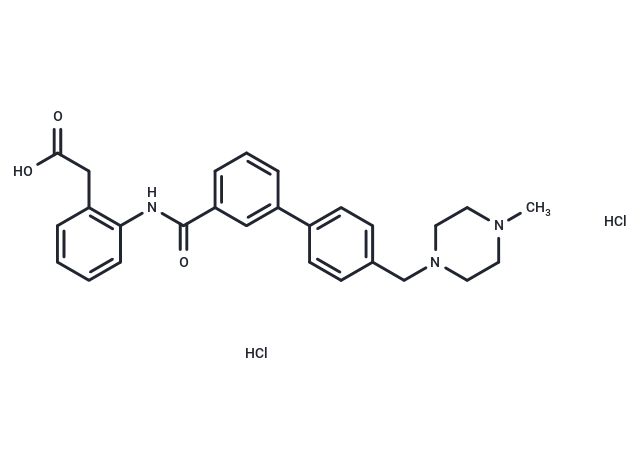 您的购物车当前为空
您的购物车当前为空
NF-56-EJ40 hydrochloride
一键复制产品信息NF-56-EJ40 hydrochloride 是一种有效,高亲和力和高度选择性的人 SUCNR1 (GPR91) 拮抗剂,IC50 为 25 nM,Ki 为 33.5 nM,对大鼠 SUCNR1 几乎没有活性。 NF-56-EJ40 hydrochloride 对人源化大鼠 SUCNR1 具有高亲和力,Ki 值为 17.4 nM。

NF-56-EJ40 hydrochloride
一键复制产品信息NF-56-EJ40 hydrochloride 是一种有效,高亲和力和高度选择性的人 SUCNR1 (GPR91) 拮抗剂,IC50 为 25 nM,Ki 为 33.5 nM,对大鼠 SUCNR1 几乎没有活性。 NF-56-EJ40 hydrochloride 对人源化大鼠 SUCNR1 具有高亲和力,Ki 值为 17.4 nM。
| 规格 | 价格 | 库存 | 数量 |
|---|---|---|---|
| 5 mg | ¥ 287 | 现货 | |
| 10 mg | ¥ 427 | 现货 | |
| 25 mg | ¥ 735 | 现货 | |
| 50 mg | ¥ 1,097 | 现货 | |
| 100 mg | ¥ 1,653 | 现货 | |
| 200 mg | ¥ 2,479 | 现货 |
NF-56-EJ40 hydrochloride 相关产品
产品介绍
| 产品描述 | NF-56-EJ40 hydrochloride is a potent, high-affinity, and highly selective human SUCNR1 (GPR91) antagonist with an IC50 of 25 nM and a Ki of 33 nM, and shows almost no activity towards rat SUCNR1. NF-56-EJ40 hydrochloride has high affinity for humanized rat SUCNR1 with a Ki value of 17.4 nM. |
| 体外活性 | NF-56-EJ40 hydrochloride 深入疏水口袋内部结合,其酸基团通过保守残基Y832.64和Y301.39的羟基以及另一侧的R2817.39进行配位。预测保守的E181.27将与NF-56-EJ40 hydrochloride 的哌嗪环形成额外的氢键。人类SUCNR1中的E221.31和N2747.32位点,在大鼠SUCNR1中被K181.31和K2697.32所取代。这两个氨基酸的交换可能由于空间位阻阻止NF-56-EJ40 hydrochloride 与大鼠SUCNR1的结合。与同源模型部分相符的放射性配体结合研究显示,人类SUCNR1的Y301.39F突变体,NF-56-EJ40的结合能力降低。E181.27K和E181.27R突变体也观察到类似效应,可能是由于赖氨酸和精氨酸残基与NF-56-EJ40 hydrochloride 的空间冲突以及与其哌嗪环的氢键丧失[1]。将人类SUCNR1的相应残基引入至大鼠SUCNR1,形成双重突变体K181.31E/K2697.32N(即人源化大鼠SUCNR1),其Ki分别为17.4 nM和33.5 nM用于人类和人源化大鼠SUCNR1。NF-56-EJ40 hydrochloride 能提高人源化大鼠SUCNR1和人类SUCNR1的热稳定性,但不影响大鼠SUCNR1的热稳定性[1]。 |
| 分子量 | 516.46 |
| 分子式 | C27H31Cl2N3O3 |
| CAS No. | 2728500-80-7 |
| Smiles | O=C(CC1=C(NC(C2=CC=CC(C3=CC=C(CN4CCN(CC4)C)C=C3)=C2)=O)C=CC=C1)O.Cl.Cl |
| 密度 | no data available |
| 存储 | Powder: -20°C for 3 years | In solvent: -80°C for 1 year | Shipping with blue ice/Shipping at ambient temperature. | ||||||||||||||||||||
| 溶解度信息 | DMSO: 5.19 mg/mL (10.05 mM), Sonication is recommended. | ||||||||||||||||||||
溶液配制表 | |||||||||||||||||||||
DMSO
| |||||||||||||||||||||




 很棒
很棒

 |
|
评论内容